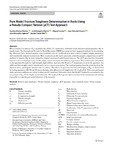Mostrar el registro sencillo del ítem
Pure Mode I Fracture Toughness Determination in Rocks Using a Pseudo-Compact Tension (pCT) Test Approach
| dc.contributor.author | Muñoz-Ibáñez, Andrea | |
| dc.contributor.author | Delgado Martín, Jordi | |
| dc.contributor.author | Costas, Miguel | |
| dc.contributor.author | Rabuñal, Juan R. | |
| dc.contributor.author | Alvarellos-Iglesias, José | |
| dc.contributor.author | Canal, Jacobo | |
| dc.date.accessioned | 2024-01-12T10:38:18Z | |
| dc.date.issued | 2020-07 | |
| dc.identifier.citation | Muñoz-Ibáñez, A., Delgado-Martín, J., Costas, M. et al. Pure Mode I Fracture Toughness Determination in Rocks Using a Pseudo-Compact Tension (pCT) Test Approach. Rock Mech Rock Eng 53, 3267–3285 (2020). https://doi.org/10.1007/s00603-020-02102-6 | es_ES |
| dc.identifier.issn | 0723-2632 | |
| dc.identifier.issn | 1434-453X | |
| dc.identifier.uri | http://hdl.handle.net/2183/34871 | |
| dc.description.abstract | [Absctract]: Mode I fracture toughness (KIC) quantifies the ability of a material to withstand crack initiation and propagation due to tensile loads. The International Society for Rock Mechanics (ISRM) has proposed four suggested methods for determining KIC. However, these methods present some drawbacks such as insufficient post-peak control, complex sample preparation and considerable material requirements. Here we present an alternative approach, called the pseudo-compact tension (pCT) method, to measure KIC in rocks using disc-shaped specimens loaded in pure tension. The pCT specimen has favourable features such as a simple geometry, small sample volume and minimal machining requirement. The tensile load is transmitted to the specimen through two high-strength, high-stiffness steel jaws that fit into a U-shaped groove cut in the specimen. An additional thin straight notch is introduced to act as a stress concentrator. The crack propagates from the notch tip along the ligament plane, splitting the specimen into two halves. The effects of specimen size and notch length on KIC are determined by testing specimens 100, 50 and 38 mm in diameter with different notch length ratios (0.1 ≤ a/b ≤ 0.4). Tests were performed under ambient conditions and a slow loading rate (0.1 mm/min). Our results show that the pCT method is convenient for the assessment of KIC of both fragile and ductile rocks. The method offers good control even beyond the maximum load, making it possible to study the post-peak behaviour of the material. | es_ES |
| dc.description.sponsorship | This work was funded by Repsol S.A., and the support from the Xunta de Galicia, the European Union (European Social Fund—ESF) and the MINECO/AEI/FEDER, UE project BIA2017- 87066-R. The authors would like to thank Dr. Manika Prasad and Kurt Livo (Petroleum Engineering Department, Colorado School of Mines) for their advice and assistance with the micro X-ray computed tomography work. The authors would also like to thank the reviewers for their comments and suggestions that helped to improve the manuscript. | es_ES |
| dc.language.iso | eng | es_ES |
| dc.publisher | Springer Nature | es_ES |
| dc.relation | info:eu-repo/grantAgreement/AEI/Plan Estatal de Investigación Científica y Técnica y de Innovación 2017-2020/BIA2017-87066-R/ES/ESTUDIO COMBINADO MEDIANTE TECNICAS PETROFISICAS Y EXPERIMENTALES DE PROCESOS TERMO-HIDRO-MECANO-QUIMICOS (THMC) ACOPLADOS A PARTIR ROCAS POROSAS SINTETICAS | es_ES |
| dc.relation.uri | https://doi.org/10.1007/s00603-020-02102-6 | es_ES |
| dc.rights | © Springer-Verlag GmbH Austria, part of Springer Nature 2020 | es_ES |
| dc.subject | Rock fracture mechanics | es_ES |
| dc.subject | Mode I fracture toughness | es_ES |
| dc.subject | pCT specimen | es_ES |
| dc.subject | Stress intensity factor | es_ES |
| dc.subject | Finite element analysis | es_ES |
| dc.title | Pure Mode I Fracture Toughness Determination in Rocks Using a Pseudo-Compact Tension (pCT) Test Approach | es_ES |
| dc.type | info:eu-repo/semantics/article | es_ES |
| dc.rights.access | info:eu-repo/semantics/embargoedAccess | es_ES |
| dc.date.embargoEndDate | 9999-99-99 | es_ES |
| dc.date.embargoLift | 10007-06-07 | |
| UDC.journalTitle | Rock Mechanics and Rock Engineering | es_ES |
| UDC.volume | 53 | es_ES |
| UDC.startPage | 3267 | es_ES |
| UDC.endPage | 3285 | es_ES |
Ficheros en el ítem
Este ítem aparece en la(s) siguiente(s) colección(ones)
-
GI-RNASA - Artigos [193]






